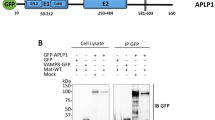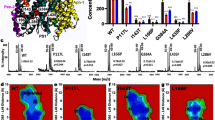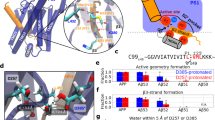Abstract
Endoproteolysis of β-amyloid precursor protein (βAPP) and Notch requires conserved aspartate residues in presenilins 1 and 2 (PS1 and PS2). Although PS1 and PS2 have therefore been proposed to be aspartyl proteases, no homology to other aspartyl proteases has been found. Here we identify homology between the presenilin active site and polytopic aspartyl proteases of bacterial origin, thus supporting the hypothesis that presenilins are novel aspartyl proteases.
This is a preview of subscription content, access via your institution
Access options
Subscribe to this journal
Receive 12 print issues and online access
$209.00 per year
only $17.42 per issue
Buy this article
- Purchase on Springer Link
- Instant access to full article PDF
Prices may be subject to local taxes which are calculated during checkout



Similar content being viewed by others
References
Selkoe, D. J. Nature 399, A23–31 (1999).
Brown, M. S., Ye, J., Rawson, R. B. & Goldstein, J. L. Cell 100, 391–398 (2000).
Haass, C. & De Strooper, B. Science 286, 916–919 (1999).
Niwa, M., Sidrauski, C., Kaufman, R. J. & Walter, P. Cell 99, 691–702 (1999).
De Strooper, B. et al. Nature 391, 387–390 (1998).
De Strooper, B. et al. Nature 398, 518–522 (1999).
Wolfe, M. S. et al. Nature 398, 513–517 (1999).
Steiner, H. et al. J. Biol. Chem. 274, 28669–28673 (1999).
Kimberly, W. T., Xia, W., Rahmati, T., Wolfe, M. S. & Selkoe, D. J. J. Biol. Chem. 275, 3173–3178 (2000).
Ray, W. J. et al. J. Biol. Chem. 274, 36801–36807 (1999).
Capell, A. et al. Nature Cell Biol. 2, 205–211 (2000).
Li, Y-M. et al. Nature 405, 689–694 (2000).
Esler, W. P. et al. Nature Cell Biol. 2, 428–433 (2000).
De Strooper, B. Nature 405, 627–628 (2000).
Cruts, M. et al. Hum. Mol. Genet. 4, 2363–2371 (1995).
De Jonghe, C. et al. Neurobiol. Dis. 6, 280–287 (1999).
Thinakaran, G. et al. J. Biol. Chem. 272, 28415–28422 (1997).
Steiner, H. et al. Biochemistry 38, 14600–14605 (1999).
Murayama, O. et al. Neurosci. Lett. 265, 61–63 (1999).
Steiner, H. et al. J. Biol. Chem. 274, 7615–7618 (1999).
Song, W. et al. Proc. Natl Acad. Sci. USA 96, 6959–6963 (1999).
Schroeter, E. H., Kisslinger, J. A. & Kopan, R. Nature 393, 382–386 (1998).
Kulic, L. et al. Proc. Natl Acad. Sci. USA 97, 5913–5918 (2000).
Huppert, S. S. et al. Nature 405, 966–970 (2000).
LaPointe, C. F. & Taylor, R. K. J. Biol. Chem. 275, 1502–1510 (2000).
Doan, A. et al. Neuron 17, 1023–1030 (1996).
Citron, M. et al. Nature 360, 672–674 (1992).
Wild-Bode, C. et al. J. Biol. Chem. 272, 16085–16088 (1997).
Wiltfang, J. et al. Electrophoresis 18, 527–532 (1997).
Steiner, H. et al. J. Biol. Chem. 273, 32322–32331 (1998).
Acknowledgements
We thank R. Kopan for the NotchΔE cDNA, and members of our laboratory for critical discussion. This work was supported by the European Community and the Boehringer Ingelheim Pharma K.G. (grant to C.H.).
Author information
Authors and Affiliations
Corresponding author
Rights and permissions
About this article
Cite this article
Steiner, H., Kostka, M., Romig, H. et al. Glycine 384 is required for presenilin-1 function and is conserved in bacterial polytopic aspartyl proteases. Nat Cell Biol 2, 848–851 (2000). https://doi.org/10.1038/35041097
Received:
Revised:
Accepted:
Published:
Issue Date:
DOI: https://doi.org/10.1038/35041097
This article is cited by
-
Enzyme-substrate hybrid β-sheet controls geometry and water access to the γ-secretase active site
Communications Biology (2023)
-
Helical stability of the GnTV transmembrane domain impacts on SPPL3 dependent cleavage
Scientific Reports (2022)
-
Transcriptional repression of the ectodomain sheddase ADAM10 by TBX2 and potential implication for Alzheimer’s disease
Cellular and Molecular Life Sciences (2019)
-
Environmental enrichment reverses Aβ pathology during pregnancy in a mouse model of Alzheimer’s disease
Acta Neuropathologica Communications (2018)
-
Identification of disulfiram as a secretase-modulating compound with beneficial effects on Alzheimer’s disease hallmarks
Scientific Reports (2018)



